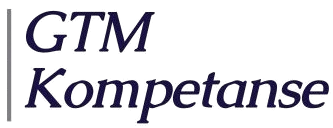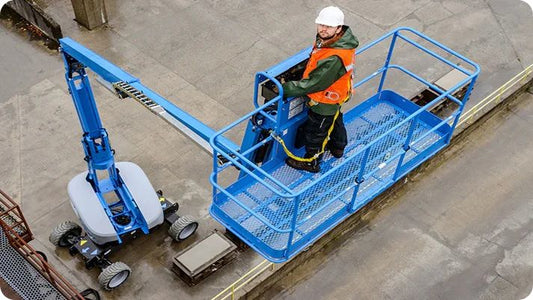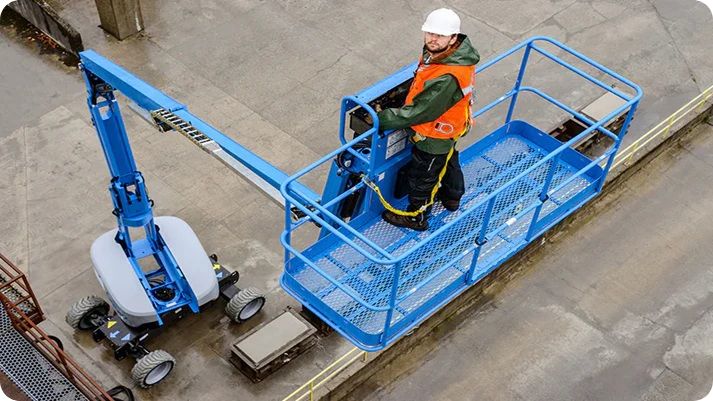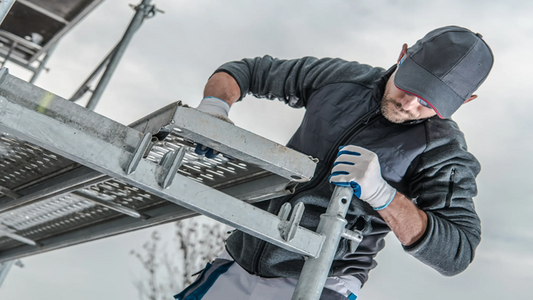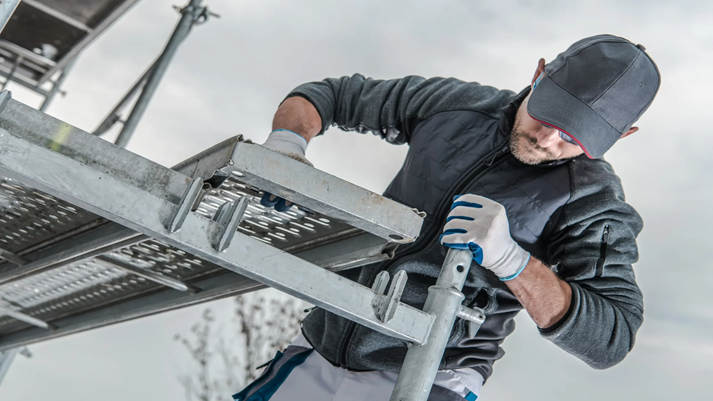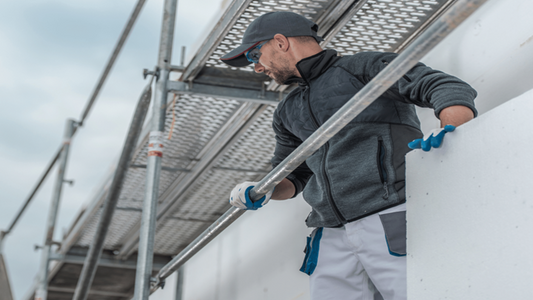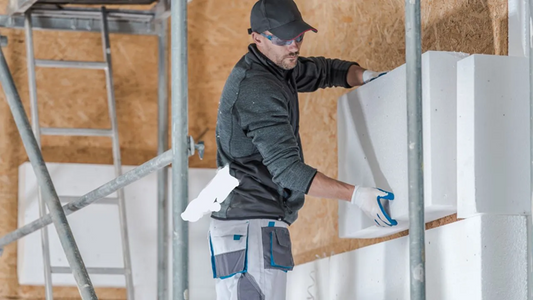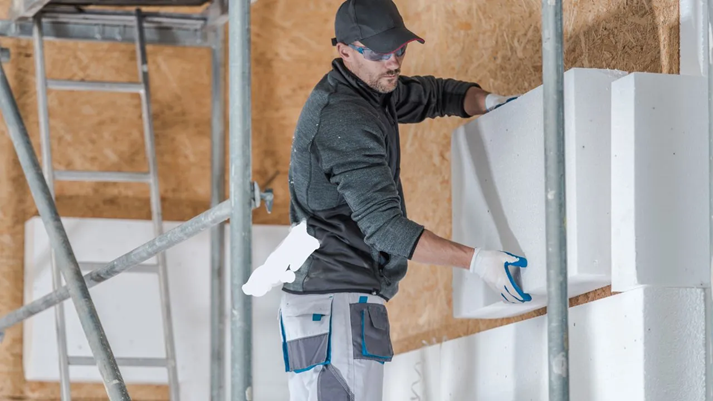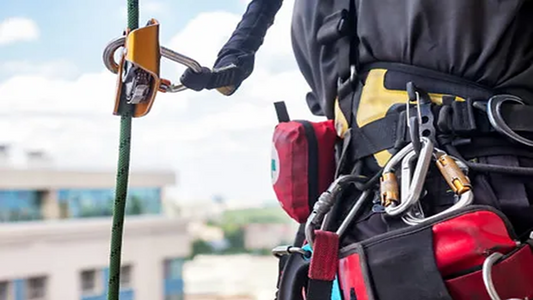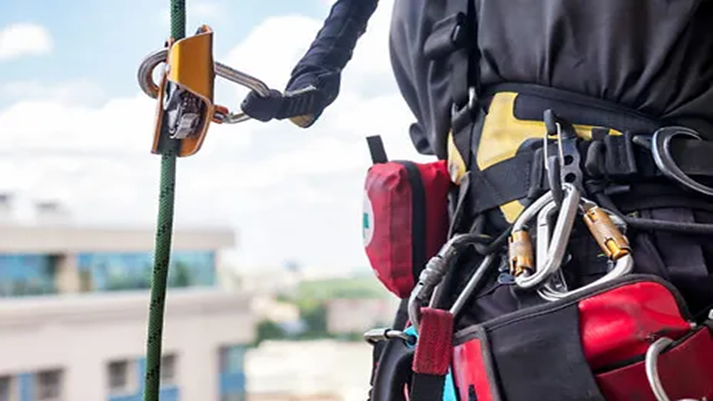In today’s job market, safety and documented training are essential – not only to comply with laws and regulations, but also to ensure that all workers thrive in a safe and productive environment. In this comprehensive guide, we cover everything you need to know about lifting training – from what the course entails, who must take it, and whether it is actually mandatory, to a deep dive into the content and benefits of taking the course online. We also present practical information on how you can easily complete our online lifting training course and achieve the documented safety training required by Norwegian authorities.
What is a lift course ?
A lift course is a specialized training course that provides participants with the necessary theoretical and practical knowledge to handle and operate lifts – also known as personal lifts – in a safe and efficient manner. This course covers everything from the basic building blocks of a lift to advanced topics such as maintenance, inspection routines and handling unexpected incidents and accidents.
Why is lift training important?
Lifts are machines that are often used in workplaces where there is a need to reach heights, whether it is construction sites, industrial environments or other high-risk areas. Incorrect operation of a lift can lead to serious personal injury and, in the worst case, life-threatening situations. Therefore, it is essential that those who will operate or be in the vicinity of such machines have a thorough understanding of safety procedures and correct use.
By taking a lift course you will achieve:
-
Increased safety : Having thorough knowledge of the lift's structure, operation and safety procedures reduces the risk of accidents.
-
Documented training : Employers have a legal responsibility to ensure that their employees have the necessary training, and a documented safety training course helps meet this requirement.
- Improved working environment : Better training results in a safer and more efficient working environment, which in turn can reduce the risk of costly work accidents and downtime.
Who needs to take a lift course ?
Which professional groups are relevant?
Basically , all employees who will operate or be directly involved in the use of lifts should complete a lift course . This includes:
- Operators : Those who directly operate the lift and are responsible for the day-to-day operations.
- Maintenance personnel : Employees who perform regular checks and maintenance of the lifting equipment.
- Safety managers : Those who have overall responsibility for ensuring that the workplace follows current safety procedures.
- Planners and supervisors : Although these do not necessarily operate the lift, it is important that they understand how the machine works in order to plan safe work processes.
Employer's responsibility
According to the Regulations on the Performance of Work § 10-2, the employer has a statutory responsibility to ensure that all employees have the necessary training to handle work equipment, including lifts. This means that if your employees are going to operate a lift, they must complete a course that documents that they have the necessary safety training.
This responsibility is not only a legal obligation, but also a key element in creating a safe workplace. By ensuring that employees are well informed and trained, the risk of accidents and injuries is significantly reduced.
Anyone who will operate or work near lifts must have a thorough lift training course . This includes both direct operators and other employees who may be responsible for maintenance or supervision. Documented training is a requirement to ensure a safe workplace and to comply with applicable regulations.
Is a lift course mandatory?
Legal requirements and safety standards
Yes, lift training is mandatory in many cases – but it is important to understand that it is not necessarily a course requirement for all employees in general, but a requirement for those who will handle and operate work equipment such as lifts. According to the Regulations on the Performance of Work § 10-2, all employees must have documented safety training to ensure the safe use of work equipment. This means that if your work tasks involve the use of lifts, then a lift training course is a legally required measure to meet these requirements.
Employer's duty
The employer is responsible for ensuring that training is completed before the employee is put to use the equipment. A documented lifting course not only helps to meet legal requirements, but is also an investment in employee safety and competence. With the right training, the risk of work accidents is significantly reduced, which in turn can have a positive effect on the working environment and overall productivity.
Key point: Lift training is mandatory for employees who will operate lifts, because it is the employer's responsibility to ensure that all employees have the necessary safety training in accordance with Norwegian regulations. This ensures a safe workplace and reduces the risk of accidents.
The content of our online lift course
Our online lift course has been carefully designed to provide you with a complete and up-to-date introduction to the safe use of lifts. The course is divided into several modules, each with its own focus area, to ensure you get the necessary theoretical knowledge and practical guidance you need. Let’s go through the most important parts of the course:
1. Laws and regulations
This is the foundation of all training related to work equipment. You will learn about:
- Relevant laws and regulations governing the use of lifts.
- How these regulations affect both the employer and the employee.
- What consequences a lack of training can have for the company's safety and legal liability.
2. The structure of the lift
To be able to use a lift safely and effectively, it is important to understand how it is constructed:
- Review of the various components of a lift.
- Explanation of technical specifications and features.
- How different models can vary, and what you need to be aware of when choosing and using them.
3. Operation and user features
This module deals with the actual use of the lift:
- Basic operating procedures to ensure safe operation.
- The user interface and how to navigate the control panel.
- Important safety procedures during start-up, operation and end of use.
4. Classification and applications (Classification ABC)
Understanding the types of lifts that exist and how they are classified is essential:
- What the different classes (A, B, C) mean in practice.
- What work tasks and environments they are best suited for.
- How correct classification contributes to optimal safety and efficiency.
5. Maintenance and inspection
Regular maintenance is essential to prevent failures and ensure a long life for the equipment:
- Routines for periodic inspection and maintenance.
- How to identify potential problems before they develop into dangerous situations.
- Checklists and procedures that ensure that the lift is always in top condition.
6. Safe use and operation
This part of the course focuses on the actual practical use:
- Safety procedures for daily use.
- How to handle unforeseen events and risks.
- The importance of following updated guidelines to minimize the risk of accidents.
7. Handling of accidents and incidents
Despite the best safety measures, accidents can happen. Here you will learn:
- What to do if an accident occurs.
- Immediate measures to minimize the extent of damage.
- Reporting and documentation of incidents to prevent future accidents.
Modular structure for an engaging learning experience
The course is structured into several modules that combine animation, text and images. This not only makes it easier to digest the theoretical knowledge, but also provides a varied and engaging learning environment. After you have gone through all the modules, the course ends with a theory test that ensures you have acquired the necessary knowledge.
How does our online lift course work?
Flexibility and availability
One of the biggest advantages of our online lift course is its flexibility. The lift course is designed to be completed on your PC, smartphone or tablet – completely independent of time and place. This means you can plan the training according to your own schedule and at your own pace.
Practical and theoretical training in one
Our course combines theoretical training with practical documentation. After the thorough theoretical review, you must also document practical training in use and safety. This is done through a separate form that you will find integrated into the course. Practical training is then taken in your own company, ensuring that you receive customized training that is relevant to your specific work environment.
Modern learning methods
We have implemented modern learning technology in our course:
- Interactive modules: Each module is designed to be interactive, with visual aids such as animations and images.
- User-friendly platform: Our learning platform is intuitive and easy to navigate, allowing you to fully focus on your training.
- Theory test: At the end of the course, you will complete a theory test that documents your knowledge and understanding of the safety routines.
Course duration
The course duration is designed to provide you with a thorough introduction without being too time-consuming. In approximately 2–3 hours, you will receive a comprehensive theoretical introduction to the lift's functions and safety procedures, combined with the practical training required to document your mastery of the necessary skills.
Benefits of our online lift course
When you choose to complete our online lift course , you will receive a number of benefits that put you and your company in a better position to meet the demands of today's job market.
1. Fulfillment of legal requirements
As mentioned earlier, it is the employer's responsibility to ensure that all employees who will operate lifts have the necessary training. Our course provides you with a documented safety course that meets the requirements of the Regulations on the Performance of Work § 10-2 . This means that you as an employee, or your employer, can be confident that all legal requirements have been met.
2. Learn at your own pace
One of the biggest advantages of an online course is its flexibility:
- Availability: Complete the course at your convenience, whether it's early morning, mid-afternoon, or late evening.
- Self-directed learning: You set the pace – whether you want to take breaks or delve deeper into certain topics is entirely up to you.
3. Cost-effective and time-saving
By choosing an online course, you save both time and resources:
- Reduced travel time: No need to travel to a physical course location.
- Flexibility in planning: You can combine training with your daily work tasks without having to take long periods of time away from the workplace.
- Increased efficiency: Quick access to learning materials and the ability to repeat difficult topics provide a better learning experience.
4. Updated knowledge and best practices
Safety standards and work procedures are constantly evolving. With our lift course you will receive up-to-date information about:
- The latest laws and regulations that apply to work equipment.
- Best practices for safe use of lifts.
- New technological solutions and methods for maintenance and control.
5. Engaging learning experience
We have placed great emphasis on making learning as engaging as possible:
- Visual aids: Animations and images help visualize complex concepts.
- Interactivity: The modules are designed to keep you engaged, so that you actively participate in the learning process.
- Feedback: Throughout the course, you will have the opportunity to test your knowledge, which strengthens the learning outcome and ensures that you have understood the most important safety routines.
Course certificate and documentation of practical training
An important aspect of our online lift training course is the documented training. After completing the theoretical course and practical training, you will receive a course certificate that documents that you have met the necessary safety requirements. This course certificate is a valuable confirmation that you are qualified to operate lifts safely.
How is the practical training documented?
- Practical Training Form: During the course, you will have access to a form where you can document your practical training. This form should be completed after you have completed the required practical exercises in your company.
- Collaboration with the employer: The employer is an integral part of the training process and must confirm that you have completed the practical training in accordance with the guidelines.
- Course certificate: After passing the theory test and confirming practical training, you will receive a course certificate that can be shown to regulatory authorities and document that you meet the requirements for the safe use of lifts.
This course certificate acts as a seal of quality, ensuring that both you and your employer have done everything required to create a safe workplace.
User experience and feedback
Our experience with the online course has shown that it provides both practical and theoretical added value to everyone who works with lifts. Many participants have given positive feedback about:
- Easily accessible learning platform: The flexibility to take the course when it suits you, and the ability to repeat difficult material, has been greatly appreciated.
- Engaging and interactive content: The combination of animations, text, and images makes complex topics easier to understand.
- Documented safety training: Participants feel confident that they are completing a course that meets the strictest safety requirements, providing both personal and professional security.
This feedback emphasizes the importance of a thorough and well-designed course that is not only a legal requirement, but also an investment in employee safety and competence.
Conclusion and the way forward
In today's work environment, safety and documented training are paramount – especially when it comes to handling machinery such as lifts. A lift course gives you the necessary knowledge and awareness to operate lifts safely and efficiently. It helps reduce the risk of accidents, meet legal requirements, and last but not least, create a safer and more productive work environment.
The main points we have reviewed:
-
What is a lift course ?
A course that provides a comprehensive introduction to the safe use of lifts, including theory and practical exercises. -
Who needs to take a lift course ?
All workers who will operate or be directly involved with lifts, including operators, maintenance personnel and safety officers. -
Is a lift course mandatory?
Yes, for those who handle lifts, documented safety training is required in accordance with the Regulations on the Performance of Work Section 10-2. -
Course content:
The course covers everything from laws and regulations, the lift's structure, operation and user characteristics, to maintenance, control and handling of accidents. -
Flexibility and modern learning methods:
The course is available on all digital devices and allows you to learn at your own pace. -
Documentation and course certificate:
After completing the course, you will receive a course certificate that documents that you have the necessary training, which is essential both for your safety and to meet the authorities' requirements.
By investing in a thorough and up-to-date lift training course , you are taking an important step towards keeping both yourself and your colleagues safe. A solid foundation in safety training is not only a necessity to comply with the law – it is an investment in the future of your company and the workplace.
We encourage anyone who will be working with lifts to sign up for our online course. With a combination of theoretical knowledge and practical training, you will be equipped to handle workplace challenges with confidence and professionalism.
Frequently asked questions
Who needs to take a lift course ?
All employees who will operate or work near lifts must complete a lift course . This includes operators, maintenance personnel, safety managers and others who are responsible for ensuring the safety of work equipment. Employers have a statutory responsibility to ensure that their employees have completed the necessary documented safety training.
Is a lift course mandatory?
Yes, for those who will operate lifts, there is a statutory requirement for documented safety training. According to the Regulations on the Performance of Work Section 10-2, employees who use work equipment, such as lifts, must have completed a course that documents their knowledge of safe use. This is a prerequisite for ensuring safe working conditions and reducing the risk of accidents.
How long does the course take?
Our online lift course is designed to take approximately 2–3 hours, depending on how quickly you complete the theoretical modules and practical documentation in your own company.
What happens after the course?
After completing the course, a theory test will be conducted to verify that you have acquired the necessary knowledge. Upon passing the test and documenting your practical training, you will receive a course certificate that documents that you have completed the documented safety training. This course certificate is valid for fulfilling the statutory requirements for documentation of safety training.
Can I take the lift course on my mobile?
Yes, our course is completely online and can be completed on a PC, tablet or smartphone, giving you the opportunity to learn when and where it suits you best.
What topics are covered in the course?
The course covers a wide range of topics, including:
- Laws and regulations related to the use of lifts
- Lift structure and technical specifications
- Operation and user features
- Classification of lifts (classification ABC)
- Maintenance and periodic inspection
- Safe use, handling of accidents and incidents
A thorough lift training course is an investment in both your personal safety and the future of your company. By ensuring that everyone who operates or is near lifts has the necessary training, the risk of accidents is significantly reduced. In a time when the working environment and safety are high on the agenda, there is no doubt that a solid course like our online lift training course is an invaluable tool.
We are proud to offer a course that not only meets legal requirements, but also gives you deep insight into both theory and practice. Our combination of modern learning technology, flexible access and documented safety training enables you to work safely and effectively – regardless of the working conditions.
Are you ready to take the next step towards a safer workplace? Contact us today to learn more about how our lift training can help you and your company meet all safety requirements while achieving a better workflow.
The way forward
Once you have made the decision to invest in your own and your employees' safety through a thorough lift training course , the next step is to set up a plan for the training. Here are some tips on how to implement the course in your workplace:
- Plan the training: Allocate time and resources for all relevant employees to complete the course. Organize training sessions that fit around working hours to minimize disruption to daily operations.
- Document the process: Ensure that all course participants receive their course certificate and that documentation of practical training is kept in a secure and accessible manner.
- Update regularly: Safety procedures and regulations can change over time. It is important to have a plan for regularly updating your course content so that employees are always up to date with the latest knowledge.
- Involve management: Management should actively support and promote safety training. This can help create a culture where safety and competence are the focus.
- Follow up with evaluations: After the course, it can be useful to conduct evaluations to ensure that the training has had the desired effect. This can help identify any areas for improvement in the course design.
By following these steps, you will not only meet legal requirements, but also contribute to a safer and more efficient working environment for all employees.
Summary
This post has provided a thorough review of what a lift course entails, who must take it, and why it is a legal requirement for those operating lifts. We have gone into depth on the content of our online course, including the theoretical and practical parts, and presented the benefits of choosing a flexible, modern, and interactive learning platform.
By investing in a well-conducted lift course , you are taking an important step towards ensuring a safe workplace where all employees have the necessary competence to avoid accidents and dangerous situations. With documented safety training as part of your company's HSE work, you also demonstrate a clear commitment to employee welfare and to complying with all relevant laws and regulations.
We hope this guide has given you all the information you need to understand the importance of a lift course , and that you now see the value of investing in a thorough training like this. Please feel free to contact us for further information or to register for our online course.
With a solid foundation of knowledge and documented safety training, you can be confident that you and your colleagues are well equipped to handle lifts safely and effectively. Don’t let lack of training be a risk – invest in a lift course today and create a safer future for everyone.
We hope you found this guide useful and educational. For more information about our courses and training services, visit our website or contact us. Let's build a safer and more competent workplace together!
